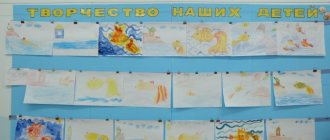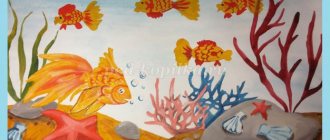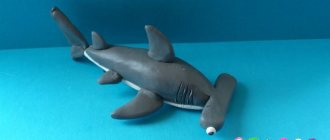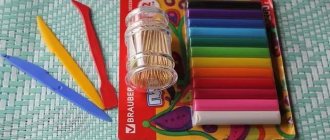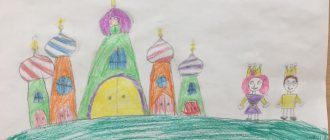Goal: development of independence, active skills of joint activities of children in the classroom. Training sessions: Strengthen the ability to draw strokes with pokes in a certain order, learn to paste ready-made shapes (circle) in a certain order, focusing on a sample. Developmental objectives: to develop children's sensory abilities - to recognize and distinguish between red, blue and yellow colors. Speech tasks: encourage the use in active speech of words denoting objects (sea, fish) and signs of objects (red, blue). Educational tasks: to develop independence and activity when choosing the color of the created image of a fish, type of activity; cultivate accuracy when choosing visual materials. Materials: “Sea” manual, a blue or light blue piece of fabric measuring 1x1 m “with seaweed” in red and yellow. Yellow and red paper fish attached to the front of the fabric. White fish “swimming” among the “algae”. Red and yellow paint (gouache), glue, red and yellow ready-made shapes for applique (circles), glue brushes, napkins, pokes, fish holders. Preliminary work. Exercise children in drawing with a brush and paints in the classroom; development of the ability to recognize and name red, blue and yellow colors; round dance game with the manual “Sea”.
Progress of the lesson:
1. Introductory part. Educator: Guys, look what we have. This is a blue, blue sea. In one distant country there is an amazing blue, blue sea. And two fish live in it - red and yellow. Do you see them? What color are they? When was the sea rough? (Swings the fabric faster) - that’s how it was worried - the fish were splashing around in the blue water. Like this. Sometimes our fish swam to the very bottom of the sea. Quickly and quickly raise your arms up and immediately lower them smoothly (3-4 times). Let's see what's there at the bottom of the sea. Who saw what? Educator: That's right, the fish there are white. What color are our fish? Red and yellow, and soon they became sad. Look how sad they have become. Sad fish? Do you know why? Because they had no friends - other red and yellow fish. Do you want to help them? Then sit down on your chairs, and I will tell you how you can do it. Finger game:
The fish swam, the fish swam, waved its tail, waved its tail, feed it quickly - it will be more fun to swim!
Educator: To help our fish, we need to make the white fish colored - red and yellow. You can color the fish with paints or with colored paper. Who wants to do what?
2. Main part:
(With the help of the teacher, children are seated at two tables)
Educator: Guys, please choose what color fish you will make - red or yellow? Look how I decorated my fish. I glued yellow circles between these stripes. Show with your finger where you will glue.
(The kids get to work, the teacher watches how the children hold the brush, spread glue on the finished forms, and glue them onto the finished bases)
Educator: Guys, look how I will decorate my fish. I want to decorate a yellow fish, so I take which fish? (Yellow). Now please choose paint colors for your fish.
(While the children are working, the teacher carries out individual work: he completes the drawing of the eye, shows how you can play with her - how she swims, how she opens her mouth, wags her tail)
3. Final part:
The teacher, with the help of the children, attaches the fish to the blanket with clothespins: red fish are near the red fish (these are her friends), yellow fish are near the yellow one. At the same time, children are asked questions.
Conversation on issues. — What color is your fish? - Which fish did she make friends with - red or yellow? — How did you paint the fish? - Did you like what you did? Educator: now our fish have many friends, they are happy. They play again, have fun and laugh. Let's see how they do it?
We are small guys, small, remote, we stood together around the sea, we raised the sea with the fish, and walked in a circle. We go, we go, we go in circles, and we squat down!
Author: Gabibullaeva Firoza Pashaevna, teacher of MBDOU DSKV No. 10 “Squirrel”
The article is published in the author's edition
On the topic: methodological developments, presentations and notes
Summary of a drawing lesson in the second junior group “Drawing Christmas trees.”
Summary of a drawing lesson in the second junior group using non-traditional drawing techniques (finger painting). Topic: “Yellow Dandelion” Prepared and conducted by: Elena Alexandrovna Kogut.
In this summary, the goals and objectives are fully indicated.
Goal: to continue to develop the work of the small muscles of the hand and the entire arm, as well as visual perception and voluntary attention through an unconventional method of drawing. Tasks: - to consolidate the skill.
Summary of a drawing lesson in the second junior group “Butterfly”. Finger painting Topic: “Butterfly” (Finger painting) Goal: to continue the development of the work of small ones.
Description of work: abstract of educational activities on visual arts (drawing) using non-traditional drawing techniques - finger and palm drawing, will be of interest to educators, born.
Notes for a sculpting lesson in the second junior group “Snails in an Aquarium” Inna Milyutina Notes for a sculpting lesson in the second junior group “Snails in an Aquarium” Lesson notes.
Source
Progress of the lesson
Introductory part (surprise moment)
(audio file with a baby crying is turned on)
The girl Masha is part of .
She's crying. The teacher draws the children's attention to Masha. Encouraging them to say hello to her. Masha: - Today the cat Vaska ate my favorite fish . And I felt very sad without her.
Educator: - Guys, let's help Masha. Let's draw a fish so that it doesn't feel sad. fish did you have ?
Educator: What color?
The teacher places images of aquarium fish , including goldfish, one .
Educator: - That's right! They float in the water. They need water to live. Do you think the fish see us ?
Finger gymnastics " Fish " arr. N. V. Nishchevoy
The fish swims in the water , the fish have fun playing .
(With their palms folded together, children depict how a fish )
Fish , fish , mischief, (They shake a finger)
We want to catch you. (Slowly bring palms )
The fish arched its back , (Again they depict how the fish )
I took a bread crumb. (Make grasping movements with both hands)
The fish waved its tail , the fish swam away again (hide the hands)
.
Educator: - This is not an ordinary fish house, but a glass one. Let's repeat the name of the house - aquarium (children repeat in chorus and several answers individually)
.
Only it's empty. Let us draw a fish so that she doesn’t cry anymore.
The teacher shows the children what he will do. his palm in the paint and applies it to the template, after which an imprint remains on the sheet. After this, he asks the children to repeat the same actions themselves.
Or he paints the child’s palm himself if this causes difficulty for the child. In this case, the fingers can be spread out or pressed, both options are possible.
Then children dip their finger in the paint and use dotted movements to make paint marks on the bottom of the aquarium . After each change of paint, wipe your palms with napkins .
Educator: - While the fish , we will play.
The fish swim in the water (make smooth (wavy)
hand movements);
Fishes have fun playing . They will clench and unclench (The hands clench into fists and unclench with their fingers outstretched)
;
Then they will bury themselves in the sand (Imitation of hands digging in the sand)
.
Final part (Reflection)
Summary of the GCD for drawing with palms in the second junior group “Autumn Tree” Drawing with palms is a very interesting and spectacular process, both for children and adults. When we draw with our palms, the work comes into play.
Summary of a lesson on applique from natural material “Goldfish” for children of the first junior group Educational area “Artistic and aesthetic development” Goal. Development of children's creative potential. Formation of ability to work.
Notes for a drawing lesson “Track for an engine” in the first junior group LESSONS FOR A DRAWING CLASSES “WAY FOR AN ENGINE” IN THE FIRST YOUNGER GROUP Notes for a drawing lesson for the first younger group. Notes for a drawing lesson “Matryoshka” in the first junior group SUMMARY OF DRAWING CLASSES “MATROSHKA” IN THE FIRST YOUNGER GROUP, Materials and equipment: Matryoshka toy, prepared. Summary of a drawing lesson in the first junior group “Puddles” Purpose: to train children in drawing a continuous rounded line, using a brush to paint the surface without going beyond the boundaries. Objectives: Educational:. Summary of a drawing lesson in the first junior group “Amanita” Goal: to expand and clarify children’s knowledge about mushrooms. Introduction to the technique of drawing with cotton swabs. Objectives: Educational: continue.
Preview:
MKDOU KINDERGARTEN OF COMPENSATING TYPE
Lesson notes on use
non-traditional drawing methods in the younger group.
Kolomna urban district
Educational areas: social - communicative, cognitive, artistic - aesthetic.
Examination of illustrations, pictures depicting fish and aquariums; observing fish in a large aquarium in a kindergarten.
A large sheet of whatman paper with an image of an aquarium, brushes, gouache paints in primary colors, wet wipes, two basins for clean and dirty wipes, a beautiful bag (for a brush), jars of water, a large doll toy, rubber toys, for choice: fish of different colors and sizes, cat, ball, dog; inflatable mini-pool with water.
Fish(t), fish(t), paint(t), water(t), brush(t), hello(t), sit(t), give(t), doll(t).
At the signal of the drum, the children approach the teacher. The teacher invites the children to sit on chairs.
1) The teacher draws the children’s attention to the table, on which there is a jar of water and a saucer of paint hidden under a napkin.
The teacher invites one child to look under the napkin and choose a sign indicating paint (choice from two signs).
If the child chooses the correct sign, praise the child and open the napkin. Otherwise, invite another child to look under the napkin and choose a sign.
2) Clarify with the children that there is water in the jar (choose a sign). Draw the children's attention that there are a lot of jars of water and saucers of paints on the children's desk.
If the child chose the sign correctly, then take out all the brushes and offer the other children the sign to choose from.
If the child makes a mistake, then the next child feels the brush.
In the process of selecting signs, the doll moves the brush over the children’s palms to allow them to feel the softness of the brush.
4) Then the teacher shows the children and the doll Masha what can be done with a brush and paint: he paints his palm with paint using a brush and makes an imprint on the paper, puts a black dot-eye with his finger. Shows it to the children.
5) The teacher invites the children to make the same prints on a large sheet of whatman paper. Children ask the doll for brushes, the doll hands out brushes, and the children thank them.
Then the children go to the work table and begin to paint their palms with paint. The teacher and nanny help to take the brush correctly and apply the paint evenly. The doll sits on a chair and looks.
Having painted their palm, the children make an imprint on whatman paper where the aquarium is drawn. The teacher or nanny quickly wipes the children’s palms with wet wipes.
5) Having examined the finished drawing, the children look for a similar object in the group. Having found an aquarium, clarify with the children by choosing the desired toy and a sign (choice of two) that there are fish in the aquarium.
Invite children to put fish toys into an inflatable pool of water and blow on them so that they float.
Source
Summary of a drawing lesson in the second nursery group “Fish”
Lolita Tseretyan
Summary of a drawing lesson in the second nursery group “Fish”
Let's color the fish .
Goal: learn to hold a brush correctly, dip it in paint, paint inside the outline, recognize and correctly name the color orange, form the correct posture when drawing .
Children complete the task. The teacher asks the children to name the toy and its color, for example: orange cube, orange ball, etc.
Well, you know the color orange well. Can you find orange paint among the paints? (Children complete the task)
.
Yes, we will use this paint to paint our fish . Only we will probably need an assistant. We will not paint the fish with our fingers . Look what the mouse brought us. (Shows a toy mouse with a brush in its paws)
. This brush is our assistant. She has a soft tail and a long handle. But you need to be able to hold the brush correctly. Otherwise, she will be offended, and our drawing will turn out ugly and sloppy. Let's learn how to pick up a brush correctly.
